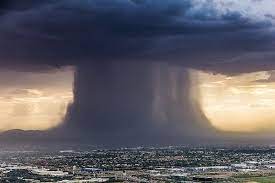A cloudburst is a sudden and intense weather phenomenon characterized by an extremely heavy and rapid downpour of rain over a localized area. This intense rainfall occurs within a short period, often lasting for a few minutes to an hour, but it can result in a significant amount of precipitation. Cloudbursts are typically associated with convective weather conditions, where warm, moist air rises rapidly and condenses into clouds, leading to the rapid formation of heavy rainfall.

Key features of a cloudburst include
- Intensity: Cloudbursts are known for their extraordinary intensity. The rainfall rates during a cloudburst can be several times higher than normal, leading to a large volume of water falling within a short duration.
- Short Duration: Cloudbursts are short-lived events, usually lasting for a relatively brief period, often measured in minutes or hours. Despite their brief duration, they can cause significant impacts due to the high volume of rainfall in such a short time.
- Localized Impact: Cloudbursts are localized events, meaning they occur over a relatively small geographical area. The heavy rainfall is concentrated in a specific region, often causing flash floods, landslides, and other related hazards.
- Convective Processes: Cloudbursts are closely linked to convective atmospheric processes. Warm, moist air near the ground rises rapidly due to factors like heating from the sun, leading to the formation of towering clouds. As the moist air ascends, it cools and condenses, releasing latent heat and causing heavy precipitation.
- Flash Flooding and Landslides: Due to the intense and rapid nature of cloudbursts, the heavy rainfall overwhelms drainage systems, leading to sudden and severe flooding. In mountainous areas, cloudbursts can trigger landslides as the excess water saturates the soil and destabilizes slopes.
Cloudbursts can have significant impacts on communities and the environment. Flash floods caused by cloudbursts can lead to property damage, loss of life, disruption of transportation networks, and damage to infrastructure. In hilly or mountainous regions, landslides triggered by cloudbursts can further exacerbate the damage.
Efforts to mitigate the impact of cloudbursts include early warning systems, improved drainage infrastructure, proper land-use planning, and measures to stabilize slopes in landslide-prone areas. Additionally, understanding the meteorological conditions that lead to cloudbursts and enhancing weather forecasting capabilities can help communities prepare for and respond to these intense rainfall events.